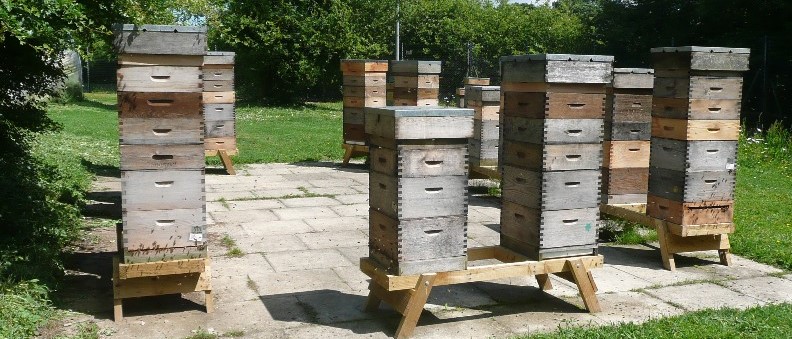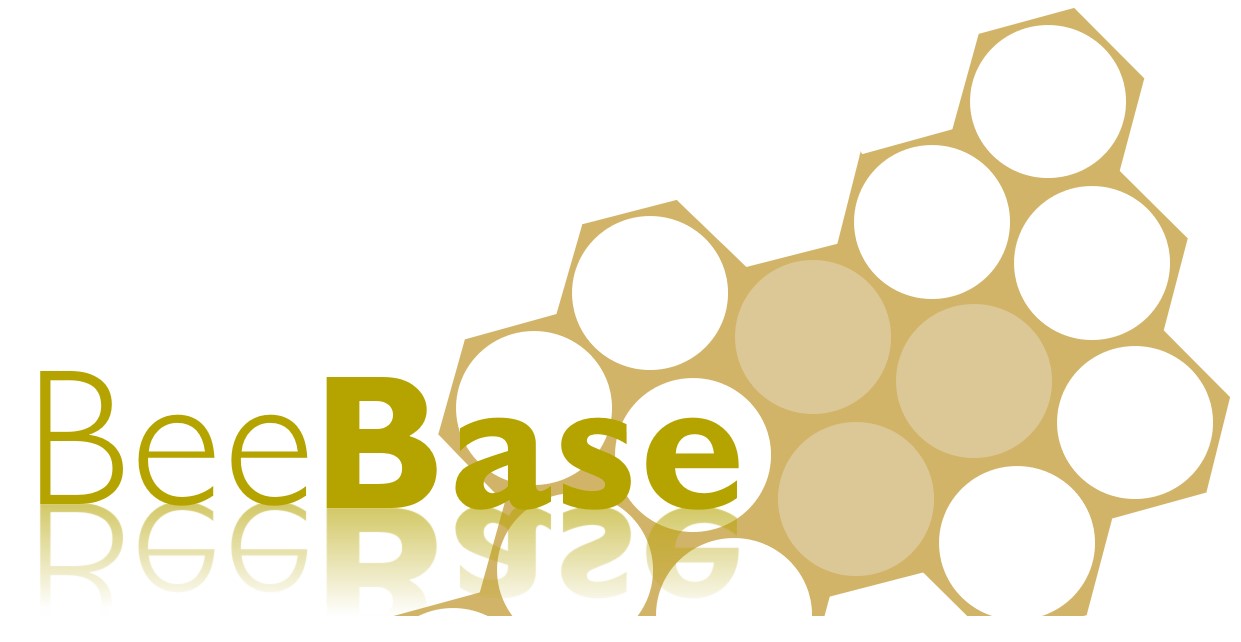Starting with Bees
Have you always wanted to become a beekeeper but didn't know where to start? Hopefully these pages will give you the information that will help you decide whether it is an appropriate hobby for you.
Most beekeepers start off with just a few colonies to study bee behaviour and obtain a small amount of honey to sell. A few colonies are all they want to manage and even those take up enough time. After a few years of experience, some beekeepers then decide to increase their stocks and go commercial. Anybody intending to be a beekeeper should firstly become familiar with honey bees, after all, the honey bee, whilst a fascinating creature, is an unusual insect to keep and it is much more difficult than you may first think!

Before taking up the craft bear the following in mind: keeping bees is a form of livestock management. They require looking after and even with a few colonies, weekly inspections are needed. Beekeepers have a duty of care to look after them properly; it can be quite demanding and heavy work at times. For example, one super can weigh in excess of 20-25kg. Additionally, shifting colonies for pollination or to different honey flows can be very strenuous and tiresome; working long hours into the night. It means making sure colonies have enough food at all times and enough space to expand the colony during the season. In the summer months, beekeepers need to carry out inspections each week:
- To control the swarming impulse (if they swarm, you'll lose up to half of the colony);
- To make sure that your colonies have young prolific queens;
- That they are kept disease free – brood should be checked twice a year, firstly in spring and the secondly in early autumn;
- To ensure that Varroa populations are kept down to manageable levels using appropriate medicines and Integrated Pest Management (IPM) systems. You cannot keep bees that are ‘Varroa free’ in the UK.
- If you find a notifiable disease (European foulbrood or American foulbrood), a notifiable pest (Small Hive Beetle or Tropilaelaps mite), or a reportable pest (Varroa), you are legally required to report it to the National Bee Unit. The following links will take you to detailed information on each of these pests and diseases:
Colony management is necessary and the following paragraphs only just touch the surface of the work that is required.
The Bees
There are different strains of the honey bee, Apis mellifera. Many in Britain are black or dark brown; others have yellow bands on their abdomens. Some bees are very easy to control, while others are virtually uncontrollable, especially in the hands of a beginner. It is very important to source bees of a docile temperament. The last thing you want in your first season is to have to deal with vicious bees and decide to give up beekeeping as a result. You cannot keep highly defensive bees in a garden close to neighbours, but you can a docile colony. You may hear from an "old timer" that defensive bees produce more honey; however, there is no connection between the temperament of bees and their potential productivity.
Honey bees are social insects and live together in colonies. The honey bee colony is composed of:
- A queen; the mother of all the bees who lays all the eggs in the colony, both unfertilised (male) and fertilised (female). Queens can live up to several years (up to 3- 4 years);
- In the summer; several hundred drones whose function is to mate with virgin queens. Drones can live up to several months;
- At the height of the summer; 50 000 to 60 000 worker bees. They are the workforce of the colony and gather what the colony requires. During the summer, they will live up to 6 weeks, while in the winter and through to early spring, they will live up to 6 months;
- From early in the year until late autumn most colonies have immature forms, collectively known as brood. These are reared in wax cells which also contain the colony's food stores.
During winter, the queen's egg laying ceases, or is greatly reduced, and the colony lives on the food that was collected during the summer. The honey bee’s ability to survive on stored food and regulate the hives temperature during unfavourable seasons or conditions has enabled it to spread to most parts of the world. During the winter, when the colony becomes inactive, the numbers of worker bees drops down to about 20,000 and the drones are usually evicted (although some over-winter). The queen is kept warm in the centre of the winter cluster.

During recent years, there has been a growing awareness of the important service bees and other beneficial insects give through pollinating many agricultural and horticultural crops as well as wild flora. The value of honey bees as a pollinator far outweighs their value as honey producers and the UK’s crop pollination industry has an estimated value that is greater than £400 million every year.
More details about this fascinating creature can be found in text books and reference websites. Try some of the sites on our useful links pages. For an example of some of the terms used in beekeeping, please see BeeCraft’s glossary page.
Apiaries – Places Where Bees are Kept
Apiaries should be sited so that only the beekeeper is ever likely to be stung by the bees. By having high walls or hedges around an apiary, bees can be forced to fly well above close neighbours. If neighbours or pets get stung, public relations can be impaired and the risk of danger to life, though small, cannot be overlooked.
Small numbers of colonies can be kept almost anywhere in the British Isles, even in urban and suburban areas and honey yields can be surprisingly high. The number of colonies kept depends on available forage and limitations of the site. If and when the beekeeper wishes to build up beyond the capacity of their home apiary, they will need to establish out-apiaries, these are apiaries away from home. It is quite feasible to keep bees away from home because, unlike other forms of livestock, bees do not require daily attention. Nevertheless, the colonies must be given attention when they require it.
An out-apiary should be readily accessible by road, throughout the year. It should be sheltered, dry and sunny and frost pockets should be avoided. Some areas, although providing food for a few colonies, are incapable of supporting large numbers throughout a whole season. In some areas it may be advisable to practice migratory beekeeping (shifting colonies to suitable crops when they are in flower). This may be for pollination or for honey.

Bee Hives
A bee hive can be described as any cavity which houses a colony of honey bees, e.g. hollow trees, holes in rocks, wooden boxes or in the traditional straw skep. Honey bees should really only be kept in movable frame hives; it makes management much more straightforward and they can be regularly checked for pests and diseases. Bees kept in non-moveable or fixed frame hives will be inspected by NBU Bee Inspectors if deemed at risk. A moveable frame system helps sound colony management and, more importantly, aids in the regular and thorough examination of brood for symptoms of foulbrood disease.
Various designs of hives may be obtained from manufacturers and equipment suppliers. The National, Smith, Modified Commercial, Langstroth and Dadant are all single-walled types. Of these, the National and Smith are the most popular in Britain. It is advisable that only one type of hive is used so that the various parts are interchangeable. There is nothing worse than going to an apiary, only to find that you have brought with you the wrong equipment for the wrong type of hive. If second-hand hives are obtained it is essential that they are free from foulbrood infection and sterilised properly. Details of how to do this can be found in our Hive Cleaning and Sterilisation leaflet.
Protective Clothing and Equipment
Stings
Bees can sting; this is something that you must consider before beginning beekeeping. You must be able to withstand bee stings, since they cannot be avoided altogether. The first sting is unlikely to cause serious disturbance, but there will be pain with some local reddening and swelling round where the sting has penetrated. With subsequent stings, swelling and reddening are likely to be more pronounced, even when the amount of injected venom is minimised by immediate removal of the sting. The swelling may persist for several days and there is likely to be some itching before the symptoms disappear. As more stings are received, immunity to their effects usually develops, although some swelling around the site of a sting is quite common, bee stings are always painful.
Unfortunately, a few people are potentially allergic to bee stings. Such persons, instead of developing immunity, become severely allergic after a few stings. Their symptoms (associated with a serious generalised reaction) include widespread red blotching of the skin, skin irritation, a change in heart rate with a falling blood pressure, difficulty breathing and fainting. Such symptoms require urgent medical attention. A person who becomes unconscious as the result of a bee sting can die.
When handling bees, protective clothing and equipment is required to minimise the number of stings. This gives a confidence which allows efficient colony management and close observation of bee behaviour. Protective clothing should comprise of:
- A bee suit, or at the very minimum, a veil, that will fully protect the head and face whilst allowing clear vision and free flow of air;
- Suitable beekeeping gloves such as disposable latex gloves which provide protection but also can be either cleaned easily or disposed of. Sheep skinned leather gloves should be avoided because they may harbour disease causing pathogens;
- Wellington boots or, working boots with protective toe caps.
Good apiary hygiene is a very important part of apiary management to prevent the spread of pests and diseases either from apiary to apiary or, colony to colony. Filthy bee suits and poor apiary hygiene such as not cleaning hive tools between each colony or leaving exposed wax, honey or feed will increase these risks.
Other essential items of equipment
A well-lit bee smoker should always be on hand to help calm the bees if they get agitated. Another essential part of the beekeeper's kit is the hive tool, which is needed for prising frames and various hive components apart, as well as scraping frames and cleaning inside hive surfaces so they are free of beeswax and propolis (a plant resin collected by bees). They come in two forms, a commercial and J type.
If you produce honey then you will need to purchase a honey extractor and a means of filtering the honey before bottling and labelling it up.

